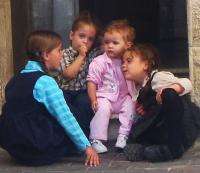Giving children non-verbal clues about words boosts vocabularies

The clues that parents give toddlers about words can make a big difference in how deep their vocabularies are when they enter school, new research at the University of Chicago shows.
By using words to reference objects in the visual environment, parents can help young children learn new words, according to the research. It also explores the difficult-to-measure quality of non-verbal clues to word meaning during interactions between parents and children learning to speak. For example, saying, "There goes the zebra" while visiting the zoo helps a child learn the word "zebra" faster than saying, "Let's go to see the zebra."
Differences in the quality of parents' non-verbal clues to toddlers (what children can see when their parents are talking) explain about a quarter (22 percent) of the differences in those same children's vocabularies when they enter kindergarten, researchers found. The results are reported in the paper, "Quality of early parent input predicts child vocabulary three years later," published in the current issue of the Proceedings of the National Academy of Sciences.
"Children's vocabularies vary greatly in size by the time they enter school," said lead author Erica Cartmill, a postdoctoral scholar at UChicago. "Because preschool vocabulary is a major predictor of subsequent school success, this variability must be taken seriously and its sources understood."
Scholars have found that the number of words youngsters hear greatly influences their vocabularies. Parents with higher socioeconomic status—those with higher income and more education—typically talk more to their children and accordingly boost their vocabularies, research has shown.
That advantage for higher-income families doesn't show up in the quality research, however.
"What was surprising in this study was that social economic status did not have an impact on quality. Parents of lower social economic status were just as likely to provide high-quality experiences for their children as were parents of higher status," said co-author Susan Goldin-Meadow, the Beardsley Ruml Distinguished Service Professor in Psychology at UChicago.
Although scholars have amassed impressive evidence that the number of words children hear—the quantity of their linguistic input—has an impact on vocabulary development, measuring the quality of the verbal environment—including non-verbal clues to word meaning—has proved much more difficult.
To measure quality, the research team reviewed videotapes of everyday interactions between 50 primary caregivers, almost all mothers, and their children (14 to 18 months old). The mothers and children, from a range of social and economic backgrounds, were taped for 90-minute periods as they went about their days, playing and engaging in other activities.
The team then showed 40-second vignettes from these videotapes to 218 adults with the sound track muted. Based on the interaction between the child and parent, the adults were asked to guess what word the parent in each vignette used when a beep was sounded on the tape.
A beep might occur, for instance, in a parent's silenced speech for the word "book" as a child approaches a bookshelf or brings a book to the mother to start storytime. In this scenario, the word was easy to guess because the mother labeled objects as the child saw and experienced them. In other tapes, viewers were unable to guess the word that was beeped during the conversation, as there were few immediate clues to the meaning of the parent's words. Vignettes containing words that were easy to guess provided high-quality clues to word meaning.
Although there were no differences in the quality of the interactions based on parents' backgrounds, the team did find significant individual differences among the parents studied. Some parents provided non-verbal clues about words only 5 percent of the time, while others provided clues 38 percent of the time, the study found.
The study also found that the number of words parents used was not related to the quality of the verbal exchanges.
"Early quantity and quality accounted for different aspects of the variance found in the later vocabulary outcome measure," the authors wrote. In other words, how much parents talk to their children (quantity), and how parents use words in relation to the non-verbal environment (quality) provided different kinds of input into early language development.
"However, parents who talk more are, by definition, offering their children more words, and the more words a child hears, the more likely it will be for that child to hear a particular word in a high-quality learning situation," they added. This suggests that higher-income families' vocabulary advantage comes from a greater quantity of input, which leads to a greater number of high-quality word-learning opportunities. Making effective use of non-verbal cues may be a good way for parents to get their children started on the road to language.
Joining Cartmill and Goldin-Meadow as authors were University of Pennsylvania scholars Lila Gleitman, professor emerita of psychology; John Trueswell, professor of psychology; Benjamin Armstrong, a research assistant; and Tamara Medina, assistant professor of psychology at Drexel University.
More information: Quality of early parent input predicts child vocabulary 3 years later, www.pnas.org/cgi/doi/10.1073/pnas.1309518110
















